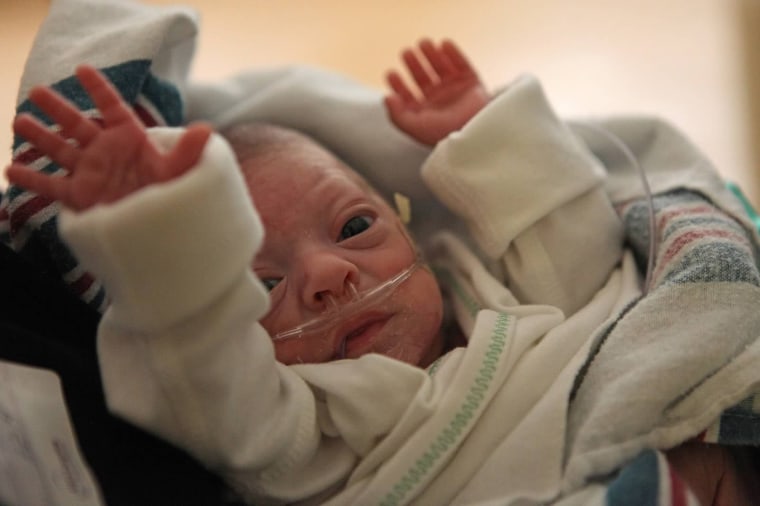The U.S. infant mortality rate has stalled, the latest government report finds, giving Americans one of the worst rates in the developed world.
Just under six out of every 1,000 babies died at birth or in the first year of life in the U.S. in 2013, triple the rate of Japan or Norway and double the rate of Ireland, Israel or Italy, the latest report from the National Center for Health Statistics finds. The rate is barely changed from 2012, although it's down 13 percent from 2005.
The highest rates were in Alabama, Mississippi and Louisiana; the lowest infant mortality rates were in Iowa, Vermont and Massachusetts, the NCHS, part of the Centers for Disease Control and Prevention, found.
“The number of infant deaths was 23,446 in 2013, a decline of 208 infant deaths from 2012,” the CDC team wrote in the report.
“One of the reasons the U.S. is so high is that we have a high preterm birth rate."
Birth defects were the single biggest cause, but the report finds a high rate of low birthweight babies and preterm births.
“In 2013, 36 percent of infant deaths were due to preterm-related causes of death, and an additional 15 percent were due to causes grouped into the sudden unexpected infant death category,” the research team wrote.
Black women had the highest infant mortality rate at 11 per 1,000 births. Cuban women had the lowest rate, at 3 per 1,000.
To compare, France has an infant mortality rate of 4 per 1,000, as does Greece. Ireland, Israel and Italy have an infant mortality rate of 3 per 1,000 while in Japan and Norway it’s 2, according to World Bank data.
The numbers tell the story of why. Teenagers and women over 40, and unmarried women, are far more likely to have babies who weigh too little at birth, who have birth defects or who are born too soon.
“In 2013, the mortality rate for infants of unmarried mothers was 7.96 per 1,000, 73 percent higher than the rate for infants of married mothers,” the report reads.
Dr. Edward McCabe, chief medical officer of the March of Dimes Foundation, says there are three main factors: doctors ignoring guidelines about inducing births too soon, unplanned pregnancies and disparities in health care.
“One of the reasons the U.S. is so high is that we have a high preterm birth rate,” said McCabe, whose charity is dedicated to preventing birth defects.
The March of Dimes organization is pressing hospitals to make it harder for obstetricians to induce preterm births. But McCabe said many obstetricians feel that 37 weeks gestation is plenty, even though full term for a baby is closer to 39 or 40 weeks.
“People don’t see the small increased risk as significant,” McCabe told NBC News. “They are putting a baby at an increased risk unnecessarily.”
And despite clear guidelines from groups such as the American College of Obstetricians and Gynecologists and the American Society of Reproductive Medicine, some IVF (in vitro fertilization) clinics still implant women with more than one embryo at a time.
More than 60,000 U.S. babies a year are born through IVF and most women are implanted with more than one embryo.
“The infant mortality rate for twins is four times the rate for single births,” McCabe said.
“The infant mortality rate for triplets is 12 times and for quadruplets 26 times the rate for single births. Most of these are not nature making the decision. Most of these are the providers together with the family.”
Disparities are a second big reason for the high infant mortality rate, McCabe said.
“The infant mortality rate for triplets is 12 times and for quadruplets 26 times the rate for single births. Most of these are not nature making the decision. "
“Women, especially women in underserved communities, are subjected to stress in their communities on a daily basis,” McCabe said. “There is a growing body of evidence that stress is associated with preterm birth. But also there’s infection, inflammation, diabetes, obesity, overweight. All of these things have an impact.”
Obesity, poor access to health care and teen birth rates are all high in the states with the highest infant mortality rates, experts point out.
There’s a third factor, McCabe says.
“Fifty percent of the pregnancies in the U.S. are not planned,” he said. “If they are not planned, then women aren’t talking to their providers in what we would consider a preconception health visit.”
Women who don’t know they are pregnant or about to get pregnant have no opportunity to eat more healthily or to stop smoking, drinking or taking drugs that can cause birth defects, cause their babies to be born too small or to be born prematurely, McCabe noted.

